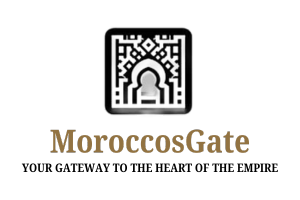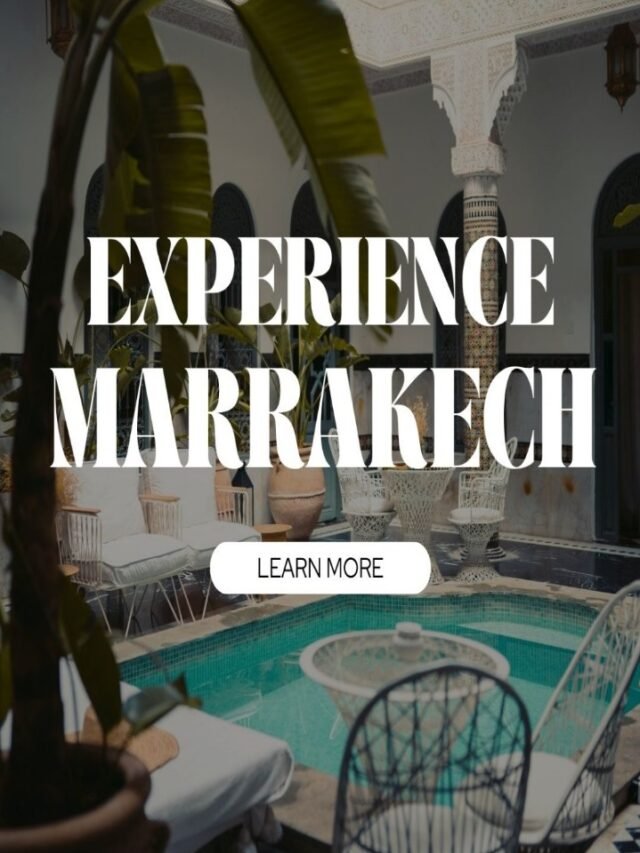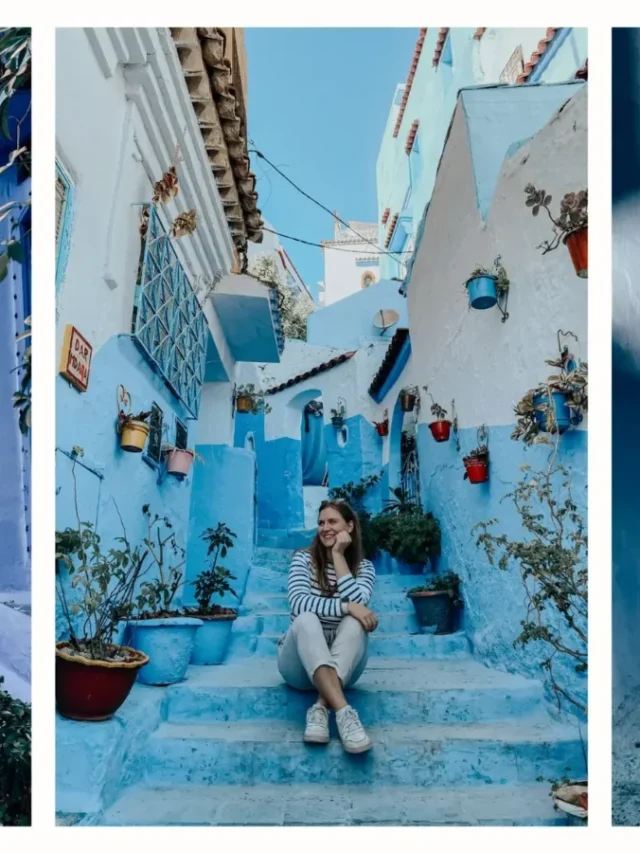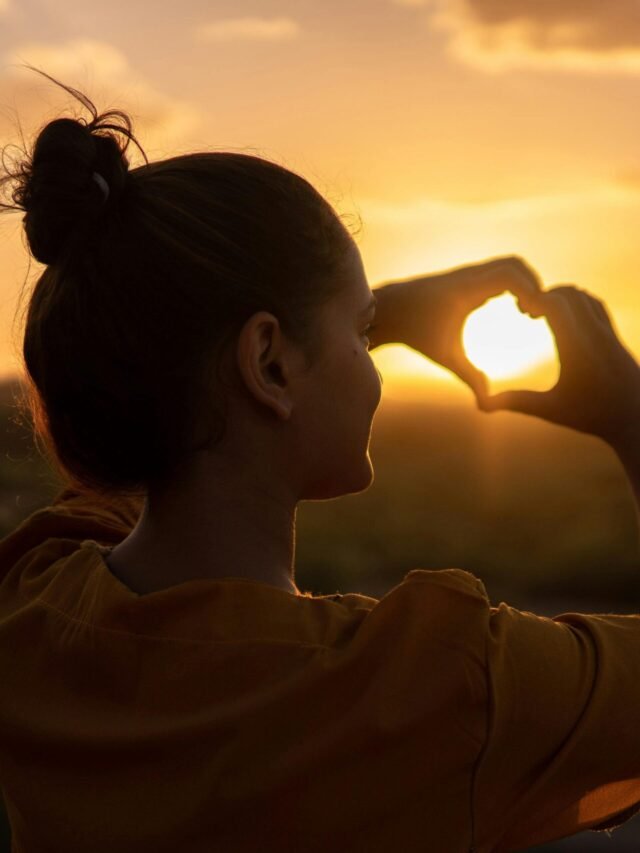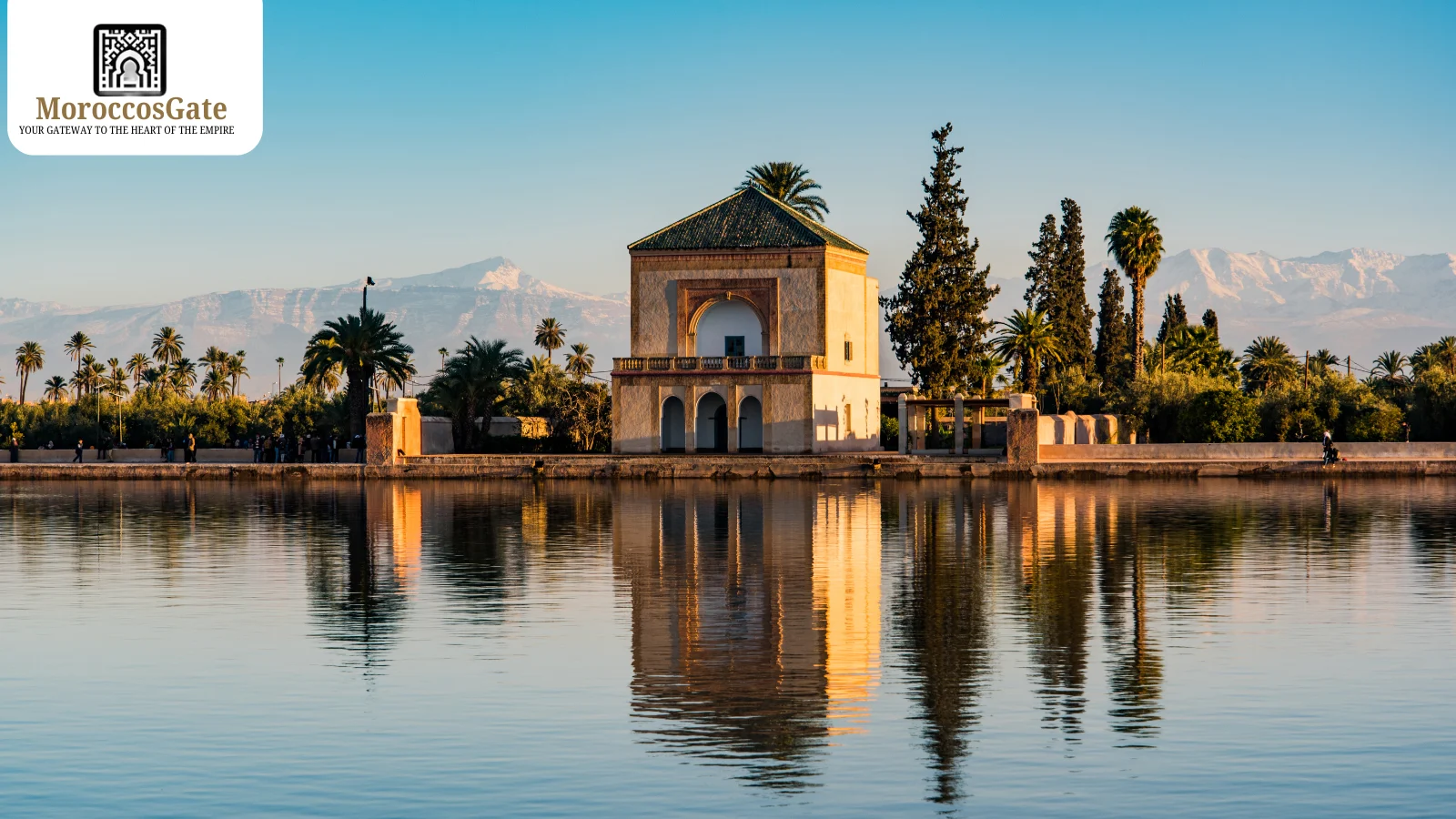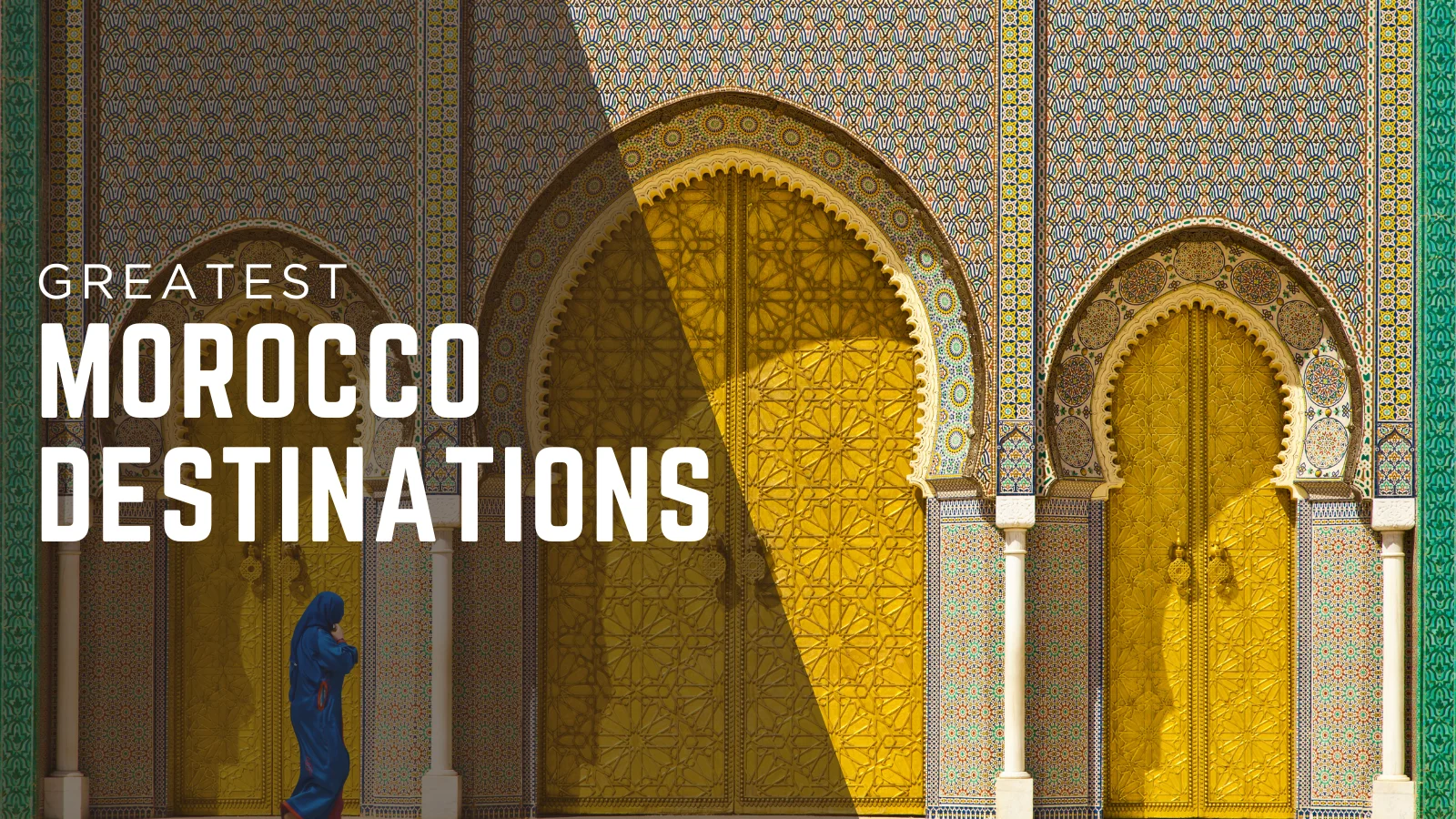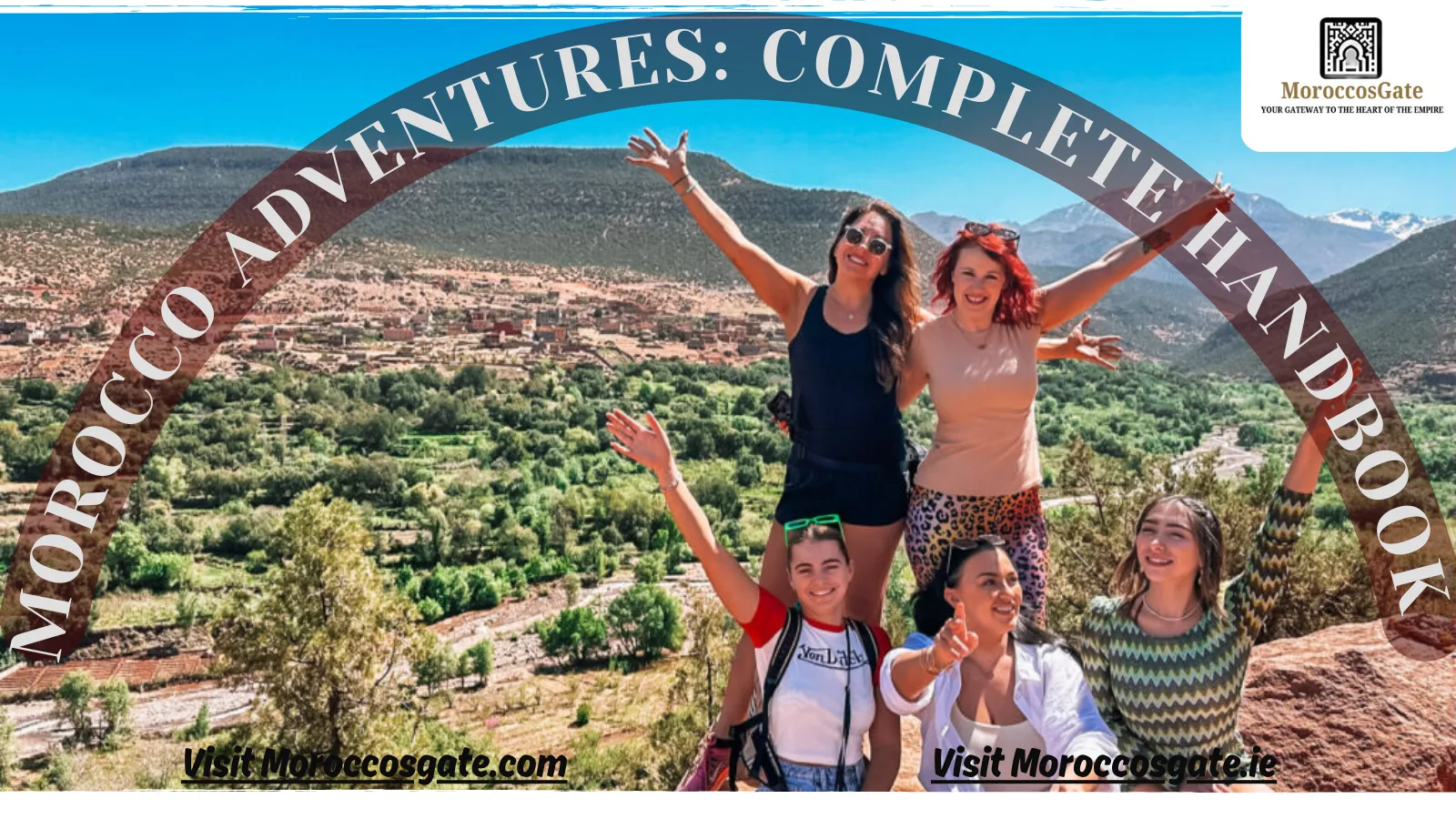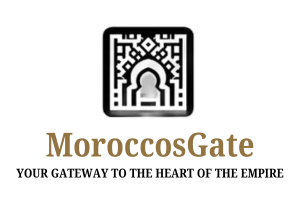Why You’ll Fall in Love with Marrakech
Marrakech, often called the Red City, captivates visitors with its vibrant colours, intoxicating aromas, and boundless energy. To experience Marrakech is to immerse yourself in a place where ancient traditions blend seamlessly with modern vibrancy, creating a unique tapestry of culture. For example, the chaotic charm of Jemaa el-Fnaa contrasts beautifully with the serene elegance of Majorelle Garden, offering something for every traveller. Moreover, wandering through the labyrinthine Marrakech Souks, admiring the grandeur of Bahia Palace, or exploring the historic ruins of El Badi Palace provides an adventure that lingers in your memory. Consequently, this guide will take you through Marrakech’s must-visit attractions, share practical tips, and help you plan a journey to experience Marrakech in all its glory.
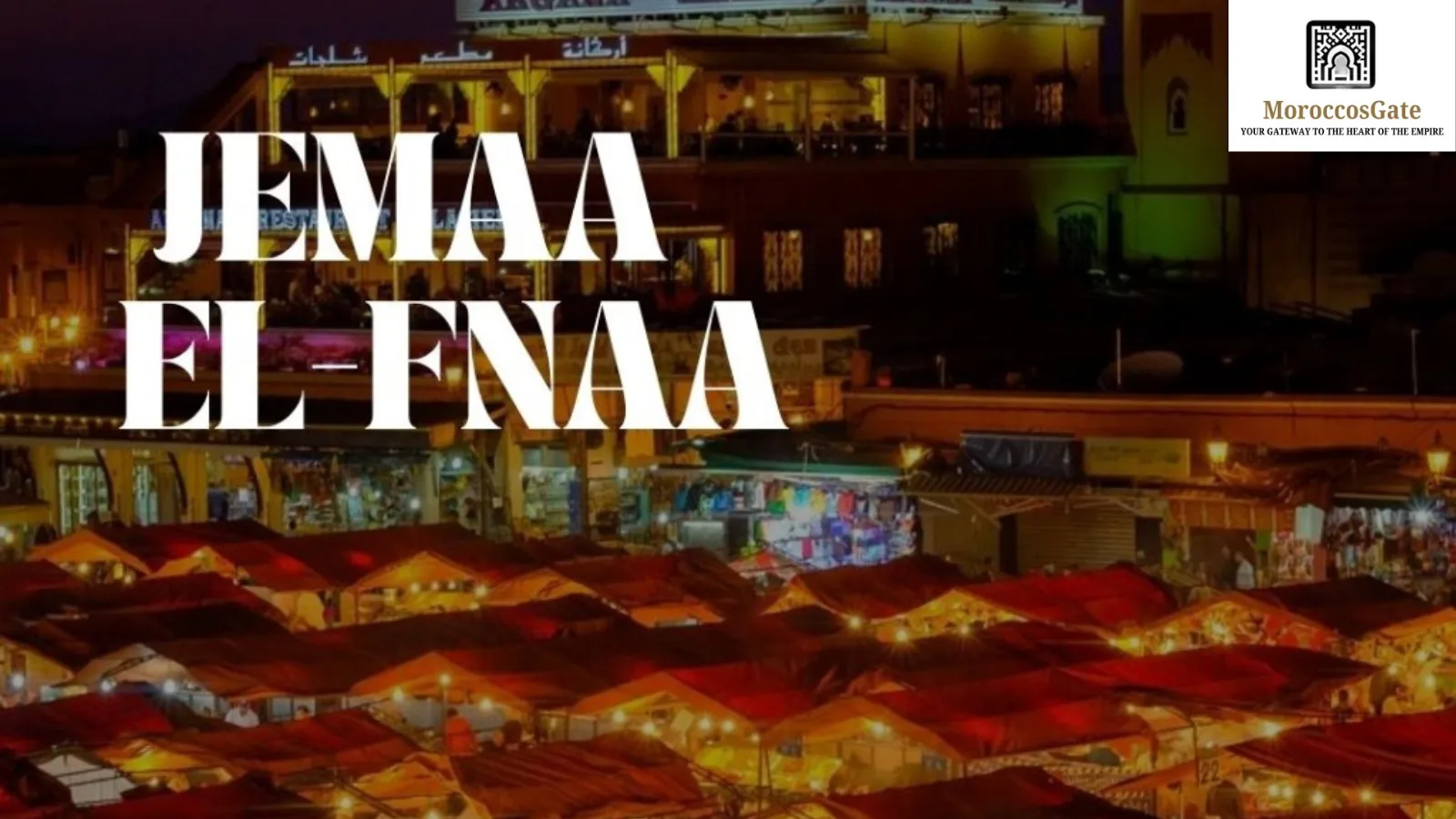
Jemaa el-Fnaa: The Beating Heart of Marrakech
A Square That Never Sleeps
To truly experience Marrakech, begin your journey at Jemaa el-Fnaa, the city’s vibrant main square. During the day, it’s a bustling marketplace where vendors sell fresh orange juice, intricate crafts, and fragrant spices. As evening falls, however, the square transforms into a lively carnival. For instance, storytellers weave tales, musicians play traditional melodies, and snake charmers captivate onlookers, creating an electric atmosphere. Thus, visiting Jemaa el-Fnaa is essential to feel the pulse of Marrakech’s soul.
What to Expect at Jemaa el-Fnaa
As you stroll through Jemaa el-Fnaa, a symphony of sounds greets you—drums, flutes, and the lively chatter of locals and tourists. Food stalls tempt with Moroccan delicacies like tagine, grilled meats, and harira soup, while henna artists and fortune-tellers add to the vibrant scene. Although pickpockets and persistent vendors can be a concern, a polite “no, thank you” usually suffices. For a breathtaking perspective, visit a rooftop café overlooking the square, where you can sip mint tea and watch the spectacle unfold below.
Tips for Visiting Jemaa el-Fnaa
- Visit at Night: The square truly comes alive after sunset, offering a more immersive experience.
- Haggle Smartly: When buying souvenirs, negotiate politely but firmly to secure a fair price.
- Stay Alert: Keep your belongings secure and avoid engaging with animal handlers if concerned about animal welfare.
Bahia Palace: A Glimpse of Royal Splendour
Architectural Marvel in the Medina
The Bahia Palace, a 19th-century masterpiece, offers a chance to experience Marrakech’s rich history. Built for Si Moussa, a grand vizier, this sprawling complex features intricate tilework, carved stucco, and tranquil courtyards. Named “brilliance,” the palace lives up to its title, with every corner showcasing Moroccan craftsmanship. Consequently, it’s a must-visit for anyone seeking to understand the city’s opulent past.
Exploring the Palace’s Highlights
As you wander through Bahia Palace, the vibrant zellige tiles and ornate ceilings captivate your senses. For example, the Grand Courtyard, with its marble floors and citrus trees, offers a serene escape from the bustling Medina. Similarly, the harem quarters, once home to the vizier’s wives, reveal the palace’s luxurious history. Therefore, you can easily spend an hour or two soaking in the beauty and imagining life in a Moroccan palace.
Practical Tips for Your Visit
- Timing is Key: Arrive early to avoid crowds, as the palace becomes busy by mid-morning.
- Guided Tours: Opt for a guided tour to uncover the palace’s history and hidden details.
- Photography: The palace is a photographer’s paradise, so bring your camera, but note that tripods are not permitted.
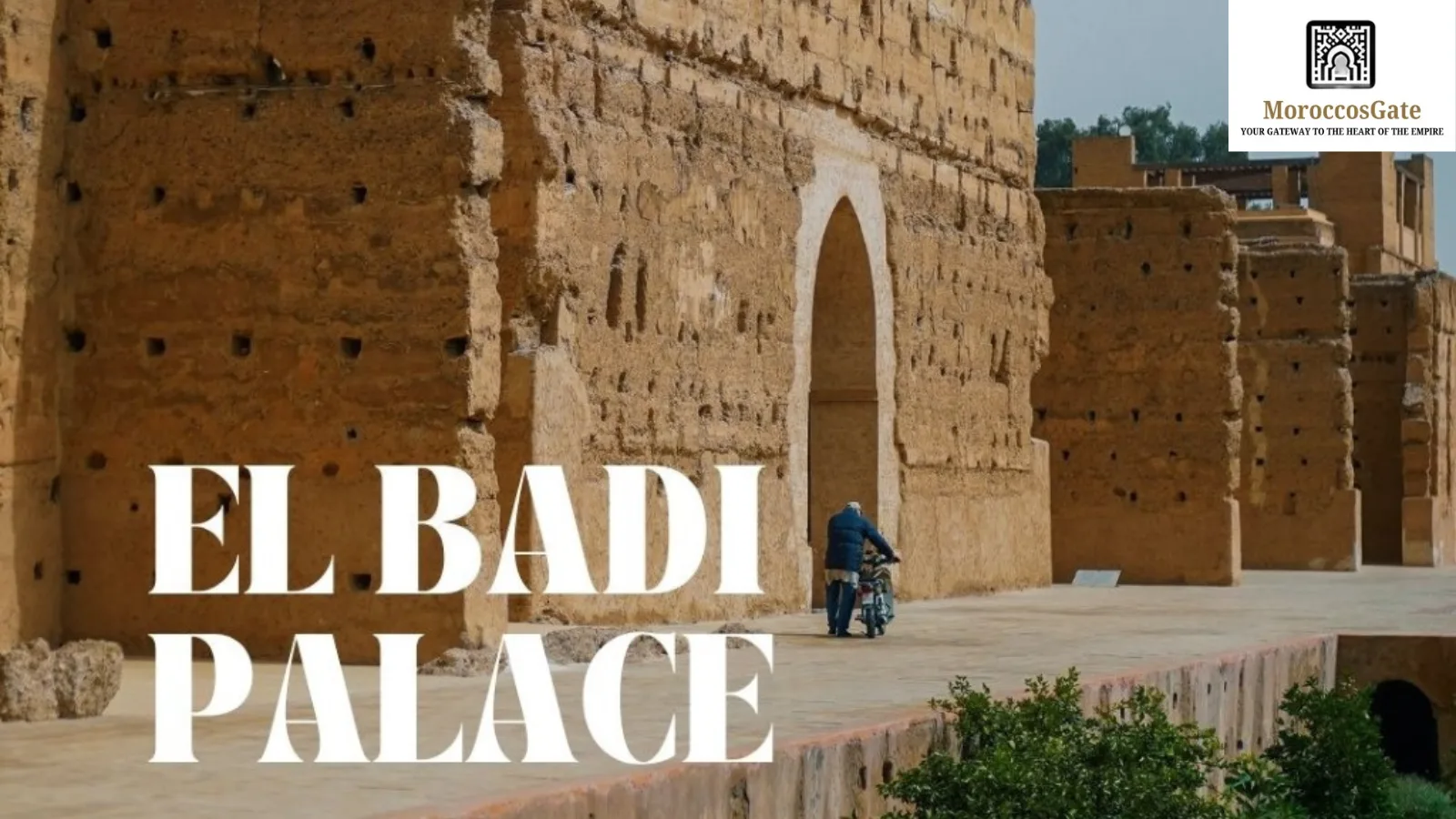
El Badi Palace: Echoes of a Golden Age
A Ruined Yet Majestic Landmark
To delve into Marrakech’s historical depth, a visit to El Badi Palace is a must. Constructed in the 16th century by Sultan Ahmed al-Mansur, this once-grand palace aimed to rival Spain’s Alhambra. Although now in ruins, its vast courtyards, sunken gardens, and stork-filled walls exude a haunting beauty. As a result, El Badi Palace offers a unique perspective on Marrakech’s past glory.
What to See at El Badi Palace
Despite its ruined state, El Badi Palace impresses with its scale. For instance, the central courtyard, with reflective pools and orange groves, hints at its former magnificence. Additionally, climbing the ramparts provides panoramic views of Marrakech, while the small museum showcases artefacts from the palace’s heyday. The stork nests on the walls add a charming touch, making this a serene spot to reflect on history.
Visiting Tips for El Badi Palace
- Combine with Bahia: Located near Bahia Palace, you can visit both in one morning.
- Entry Fee: Tickets cost around 100 MAD ($10), a small price for such a historic site.
- Quiet Corners: Seek out quieter areas to enjoy the peaceful atmosphere away from tour groups.
Majorelle Garden: A Blue-Hued Oasis
A Botanical Haven
For a tranquil escape, Majorelle Garden is the perfect place to experience Marrakech’s serene side. Created by French artist Jacques Majorelle and later restored by Yves Saint Laurent, this botanical paradise is renowned for its vibrant cobalt-blue buildings and exotic plants. Consequently, it’s an ideal spot to unwind after the hustle of the souks.
Highlights of Majorelle Garden
The garden boasts over 300 plant species, from cacti to bamboo, set against the iconic “Majorelle Blue” backdrop. Moreover, the Berber Museum, housed in Majorelle’s former studio, displays Morocco’s indigenous culture through artefacts and jewellery. The nearby Yves Saint Laurent Museum is a treat for fashion enthusiasts. With its shaded pathways and soothing water features, the garden offers a calming retreat.
Planning Your Visit
- Book in Advance: Tickets sell out quickly, so reserve online via the official website.
- Early or Late: Visit early morning or late afternoon to avoid crowds and heat.
- Combined Tickets: Choose a combined ticket to include the Berber and Yves Saint Laurent Museums for a richer experience.
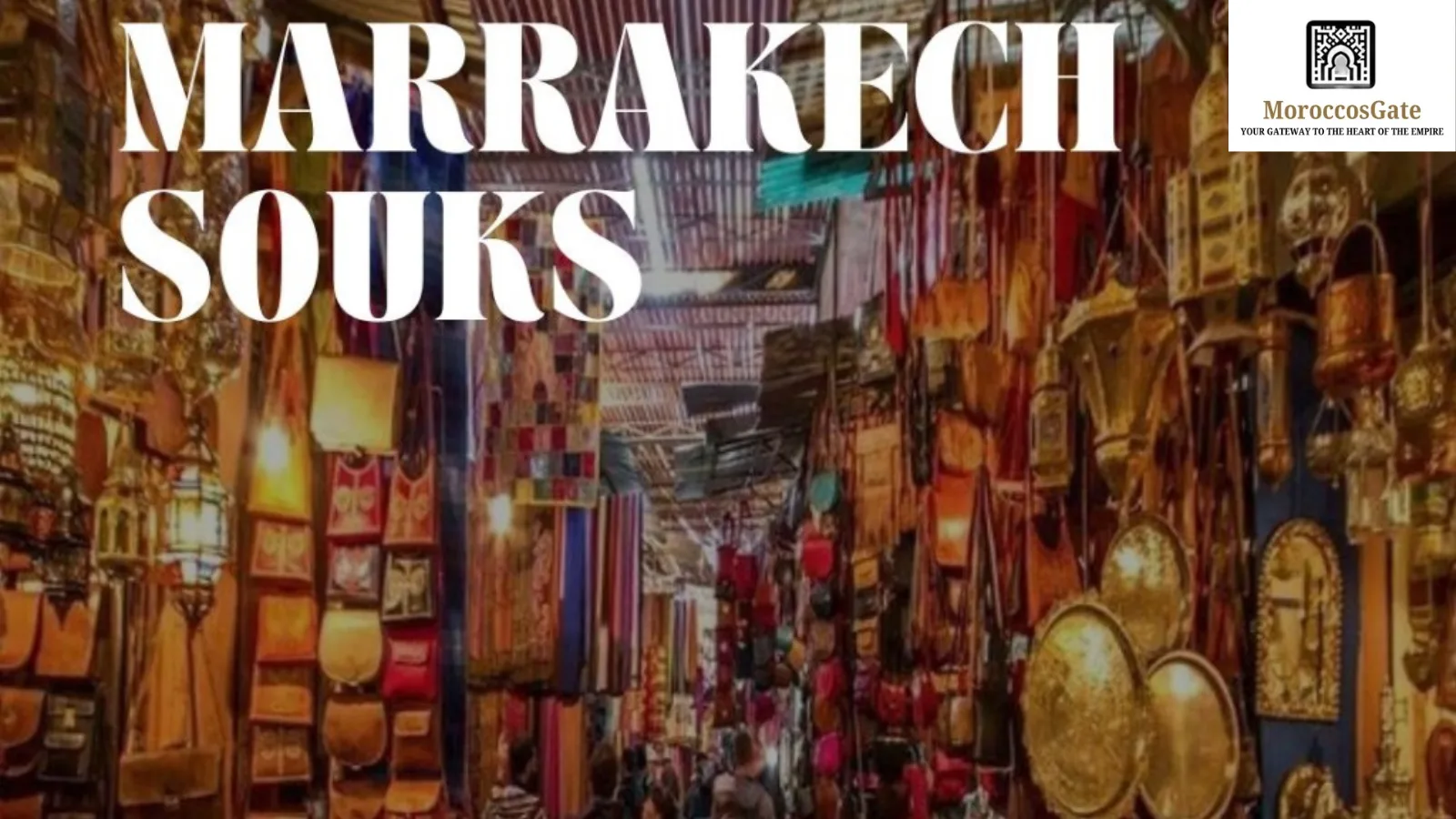
Marrakech Souks: A Shopper’s Paradise
Navigating the Labyrinth
No trip to experience Marrakech is complete without exploring the Marrakech Souks. These sprawling markets, nestled in the heart of the Medina, are a maze of narrow alleys brimming with vibrant stalls. From spices to leather goods, the souks offer a sensory feast that embodies Moroccan culture. Therefore, getting lost here is part of the adventure.
What to Buy in the Souks
The Marrakech Souks are a treasure trove of handmade goods. For example, Berber rugs, babouche slippers, and intricate lanterns are popular finds. Additionally, the spice markets in Rahba Kedima offer saffron, cumin, and other aromatic blends. Since haggling is customary, practice your negotiation skills to secure a bargain.
Tips for Souk Shopping
- Go Early: Mornings are less crowded, making navigation easier.
- Cash is King: Most vendors prefer cash (Moroccan dirhams), so carry some with you.
- Stay Respectful: Haggling is part of the culture, but keep it friendly and fair.
Beyond the Must-Visits: Hidden Gems in Marrakech
Le Jardin Secret: A Tranquil Retreat
Tucked away in the Medina, Le Jardin Secret is a serene oasis offering respite from the city’s chaos. This restored 16th-century complex features Islamic and exotic gardens, with a rooftop café providing stunning views. As a result, it’s a perfect spot for a peaceful break.
Ben Youssef Madrasa: Islamic Art at Its Finest
This 14th-century Islamic college is a hidden gem with breathtaking architecture. For instance, its intricate tilework and carved wood rival Bahia Palace, yet it’s often less crowded. Thus, it’s ideal for history and art lovers seeking to experience Marrakech’s cultural depth.
Koutoubia Mosque: A City Icon
Although non-Muslims cannot enter, the Koutoubia Mosque’s minaret is a Marrakech landmark. Visit at sunset to see its rosy glow against the Atlas Mountains, and stroll the surrounding gardens for a relaxing experience. Consequently, it’s a great way to appreciate the city’s spiritual heritage.
Saadian Tombs: A Royal Resting Place
The Saadian Tombs, dating back to the 16th century, are another hidden treasure. Rediscovered in 1917, these ornate mausoleums house the remains of Saadian sultans, with intricate stucco work and marble columns. Visiting early helps avoid crowds, making it a peaceful stop.
Dar Si Said: Museum of Moroccan Arts
This museum, located in a former palace, showcases Moroccan craftsmanship, from carpets to jewellery. Its tranquil courtyard and detailed exhibits offer a deeper understanding of Marrakech’s artistic heritage. As such, it’s a must for culture enthusiasts.
Practical Tips to Experience Marrakech Like a Local
Where to Stay: Riads in the Medina
To fully experience Marrakech, stay in a traditional riad—a historic house with a courtyard. For example, Riad Porte Royale or Riad Be Marrakech offer authentic charm and a peaceful retreat. Since spring and autumn are peak seasons, book early to secure a spot.
Getting Around Marrakech
The Medina’s narrow alleys are best explored on foot, as cars cannot navigate them. For longer trips, such as to Majorelle Garden, take a petit taxi or pre-book a private transfer. Alternatively, horse-drawn carriages (calèches) offer a scenic option, but negotiate fares upfront.
Best Time to Visit
Spring (March to May) and autumn (September to November) provide mild weather, ideal for exploring Jemaa el-Fnaa and the souks. However, summer can be intensely hot, and during Ramadan, some businesses may have reduced hours.
Cultural Etiquette
Dress modestly, covering shoulders and knees, especially in the Medina. When taking photos, particularly of people, always ask permission. Moreover, a smile and a polite greeting in Arabic, like “salaam alaikum,” can foster connections with locals.
A Day-by-Day Itinerary to Experience Marrakech
Day 1: Dive into the Medina
- Morning: Begin at Bahia Palace, followed by El Badi Palace to explore Marrakech’s royal history.
- Afternoon: Wander the Marrakech Souks, grabbing lunch at a rooftop café like Café des Épices.
- Evening: Immerse yourself in Jemaa el-Fnaa’s vibrant atmosphere, enjoying street food and live performances.
Day 2: Gardens and Culture
- Morning: Visit Majorelle Garden and the Berber Museum for a tranquil start.
- Afternoon: Explore Ben Youssef Madrasa and Le Jardin Secret for cultural insights.
- Evening: Dine at a rooftop restaurant like Nomad, overlooking the Medina’s twinkling lights.
Day 3: Deeper Exploration
- Morning: Wander quieter souks like Rahba Kedima for unique finds.
- Afternoon: Visit the Koutoubia Mosque gardens and Dar Si Said museum.
- Evening: Relax with a traditional hammam at a spa like Les Bains de Marrakech.
Food and Drink: A Taste of Marrakech
Must-Try Moroccan Dishes
To experience Marrakech’s culinary scene, savour dishes like tagine, a slow-cooked stew with meat or vegetables, and couscous with fragrant spices. Additionally, Moroccan mint tea, known as “Berber whisky,” is a refreshing staple. For an authentic taste, visit Jemaa el-Fnaa’s food stalls or dine at restaurants like Bakchich Café for modern takes on traditional fare.
Top Dining Spots
- Henna Art Café: A family-friendly spot with vegan options and henna art, perfect for a relaxed meal.
- Le Jardin Marrakech: A trendy café near Le Jardin Secret, ideal for bloggers and Instagrammers.
- Chez Chegrouni: A budget-friendly eatery near Jemaa el-Fnaa, serving classic Moroccan dishes with a view.
Street Food Adventures
The food stalls in Jemaa el-Fnaa offer an array of treats, from spicy harira soup to grilled skewers. For instance, Stall No. 1 is famous for its lamb tanjia, a slow-cooked delicacy. However, choose busy stalls to ensure freshness and avoid stomach issues.
Safety and Health Tips for Marrakech
Staying Safe in the Souks
The Marrakech Souks and Jemaa el-Fnaa can feel overwhelming, so keep valuables secure and avoid solo visits at night, especially for women. A firm but polite demeanour helps when declining persistent vendors. Additionally, use a money belt for extra security.
Health Precautions
When trying street food, stick to busy stalls with fresh ingredients to avoid hygiene issues. Moreover, check accommodation safety standards, as fire risks have been reported in some riads. Therefore, comprehensive travel insurance is highly recommended.
Cultural Insights: Understanding Marrakech’s Heritage
Marrakech’s culture is a vibrant blend of Berber, Arab, and Andalusian influences. For example, the intricate designs in Bahia Palace and Ben Youssef Madrasa reflect centuries of craftsmanship. Similarly, the music and storytelling in Jemaa el-Fnaa connect to ancient oral traditions. By engaging with locals respectfully, you’ll gain a deeper appreciation for this heritage.
Why Marrakech Stays with You
To experience Marrakech is to embrace a city that’s both chaotic and captivating. The vibrancy of Jemaa el-Fnaa, the elegance of Bahia Palace, the history of El Badi Palace, the serenity of Majorelle Garden, and the adventure of the Marrakech Souks weave a tapestry of unforgettable moments. Whether haggling for a rug, sipping mint tea on a rooftop, or wandering ancient ruins, Marrakech leaves a lasting impression. Thus, plan your trip, pack your sense of adventure, and let this Red City steal your heart.
FAQ: Your Marrakech Questions Answered
1. What is the best time to visit Marrakech?
Spring (March to May) and autumn (September to November) offer pleasant weather, ideal for exploring Jemaa el-Fnaa, Marrakech Souks, and Majorelle Garden. Summer can be very hot, and Ramadan may affect business hours.
2. How many days do I need to experience Marrakech?
Three to four days is ideal to cover major attractions like Bahia Palace, El Badi Palace, and the souks, while leaving time for hidden gems like Le Jardin Secret.
3. Is Marrakech safe for solo travellers?
Yes, Marrakech is generally safe, but stay vigilant in crowded areas like Jemaa el-Fnaa and the souks. Avoid walking alone at night and use reputable accommodations.
4. Do I need to haggle in the Marrakech Souks?
Yes, haggling is expected in the Marrakech Souks. Start at half the quoted price and negotiate politely to reach a fair deal.
5. Can I visit mosques like Koutoubia as a non-Muslim?
Non-Muslims cannot enter the Koutoubia Mosque, but you can admire its minaret and stroll the surrounding gardens for a scenic experience.
6. What should I wear in Marrakech?
Dress modestly, covering shoulders and knees, especially in the Medina and near religious sites. Lightweight, breathable clothing is best for the warm climate.
7. Are there vegetarian or vegan options in Marrakech?
Yes, many restaurants, like Henna Art Café, offer vegetarian and vegan dishes, such as vegetable tagine and couscous, especially in Jemaa el-Fnaa.
